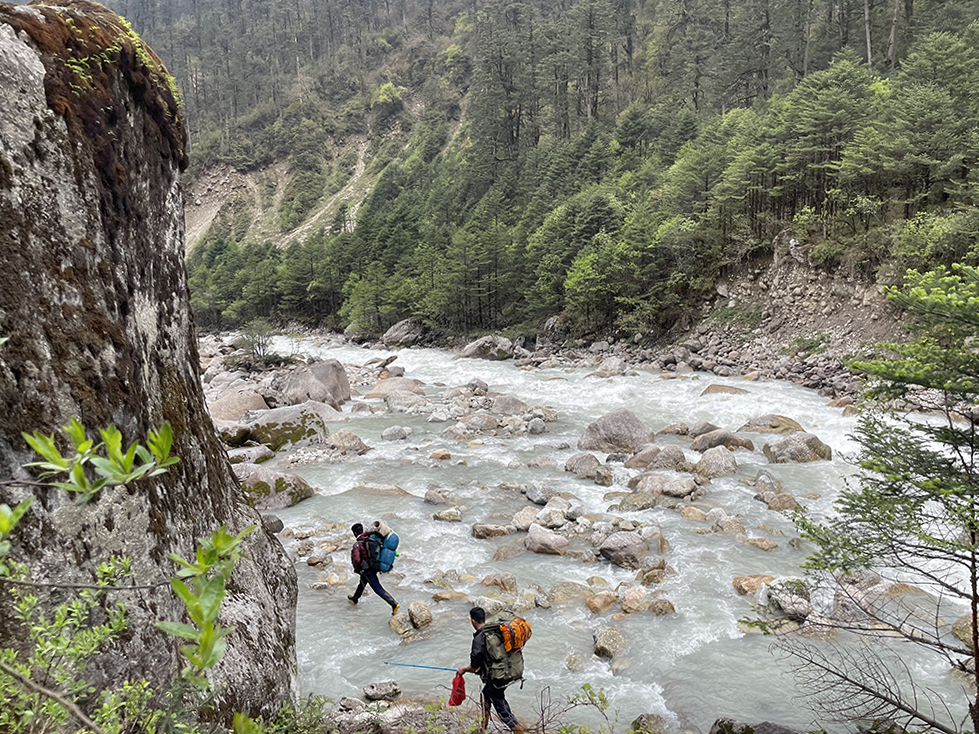Cette publication est également disponible en :
![]() Français
Français

Thesis defended by Nazimul Islam, February 17, 2025 – Institute of Earth Surface Dynamics (IDYST).
Mountains are the ‘water towers’ that deliver freshwater to millions of people living downstream. Despite their importance, mountain regions are data-poor with complex terrain that makes space-time transferability of knowledge related to climate change impacts on water resources difficult. As a result, we know very little about past environmental variabilities in the high-altitude mountain basins. Therefore, to plug this data gap, my PhD focused on tree growth-climate relationships and hydrological reconstructions for better understanding of how climate change affects water resources in the Alpine and Himalayan river basins. This thesis addressed the following research questions:
Q1. How does climate warming influence the relationship between temperature, precipitation and tree growth in Alpine environments? Is it possible to identify an altitude dependent breakpoint in climate forcing of tree growth in the Turtmann River basin?
Q2. Can we use intra-annual information (earlywood and latewood) including isotope variations in tree rings to understand seasonal changes in the growth of trees and the relationship to water use in Alpine environments?
Q3. Can the anatomical analysis of tree rings be used to reconstruct past history of river flow in a poorly gauged/ ungauged river in the Eastern Himalaya?
Q4. Is it possible to detect the changing water sources for tree growth using annually resolved tree ring stable isotope compositions in poorly gauged mountain river basins?
This thesis investigated at what elevation climatic signal switches temperature-limited to precipitation-limited growth for the European Larch (Larix decidua) in the Turtmann river basin. A transition zone (i.e., an elevational breakpoint) was identified between 900 m and 1800 m above mean sea level (m.s.l.) where this climatic signal switches, and this elevation breakpoint appears to be rising with time due to increasingly warmer annual average temperatures in this Alpine basin. This thesis also developed 75 years (1946-2020) of stable oxygen (δ18O) and hydrogen (δ2H) isotope records from tree rings from Turtmann basin. Isotopic compositions of both δ18O and δ2H of trees close to the river fed by glacial meltwater are lower that reflected ice melt signals, whereas trees distal to the river reflected summer precipitation and snowmelt signals but are not influenced by the glacial meltwater draining from the headwater basin and/or released by the dam. This study provided novel scientific understanding that trees at the proximity to the river can benefit from accessing glacial meltwater for their growth compared to trees that do not have access to glacial meltwater under changing climate.
In the Himalayan river basins, following a systematic literature review on the state of the art and future directions of tree-ring hydrological studies, 182-years (1840-2021) long pre-monsoon streamflow record of Zemu River was reconstructed in the Upper Teesta River basin. This reconstruction was carried out based on a strong negative relationship between a century long tree-ring chronology of Bhutan fir (Abies densa) species and observed streamflow record. This counterintuitive, inverse relationship is likely due to the additional contribution of temperature warming induced glacial meltwater supply. Streamflow reconstruction record of this poorly gauged river identified 30 high-flow years (including the documented 1968 Sikkim flood and the 1998 Assam flood), and 33 low-flow years. This study also highlighted a positive association between reconstructed pre-monsoon streamflow record and the global climate forcing (e.g., ENSO), which may reduce penetration of the Indian Summer Monsoon during ENSO years, leads to a decrease in precipitation but maintains higher glacier melt due to long warmer and drier conditions in this basin. Furthermore, 72 years (1950-2021) of annually resolved stable isotope record developed from tree rings of A. densa species showed an increase in δ18O and δ2H isotopic compositions over the analysis period. Results suggested that in the Zemu River (i.e., the headwater catchment in the Upper Teesta basin), snowmelt and monsoon precipitation are the major contributions to the streamflow.
Overall, the results of this thesis show that climate change has significant consequences on tree growth and streamflow variabilities in the high-altitude glacier-fed river basins. These findings have important implications for sustainable management of freshwater resources in the Alpine and Himalayan river basins.


